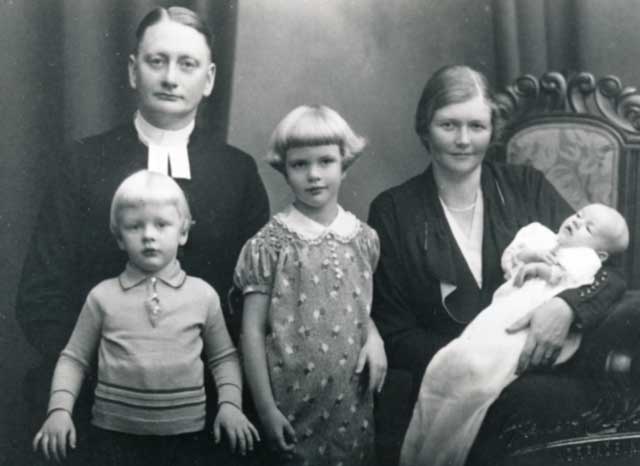[No author found yet for the profile.
Please use the contact form below to get in touch with us.]
Life and ministry
Tentative timetable:
- 1898: Martin Nordfeldt was born in Norrköping, Sweden
- 1924: Married to Ingeborg Nordfeldt, née Ericsson.
- 1924: Arrived in Nekemte
- 1927: Moved to Najo (with regular visits to Boji)
- 1936: Returned to Sweden (Italian invasion)
- 1938-54: Rev. Nordfeldt served as a missionary in today’s Tanzania: Ilula (1938-41), Kidugala (1941-42), Ilembula (1942-49), Kidugala (1949-54).
- 1954: Return to Sweden;
SEM’s work was handed over to the Norwegian Lutheran Mission - 1976: Rev. Nordfeldt passed away in Sweden
Excerpts from Arén (1999), Envoys of the Gospel:
1) Early ministry in Ethiopia
[p. 301] Rev Martin and Mrs Ingeborg Nordfeldt arrived in Nekemte for evangelistic and educational work in 1924. Originally, they had been assigned for Eritrea but were refused entry into the Italian colony.
“[p. 303] Besides teaching classes with Ato Gebre-Yesus Bambe, the primary school teacher, as interpreter, the Nordfeldts set about to study Amarinya as required by the government in Addis Abeba. At the same time they commenced to learn vernacular Oromo from Onesimos and Aster in order to be closer to the people. Qes Martin, the name by [p. 304] which Nordfeldt generally was called, had parts of the liturgy translated into Oromo, since several church-goers did not understand Amarinya. He also gave instruction in the Christian Faith to a first group of eight confirmands to prepare them for sharing in Holy Communion.”
2) Najo (and Boji)
p. 306f: In 1927, the Nordfeldts moved to Najo. School work began in earnest in 1929 with Gamachis Onesimos as teacher of literacy.
p. 308: Rev. Nordfeldt served also at Boji from time to time
p. 329: Rev. Nordfeldt was a key figure in the construction of a church building at Najo.
“[p. 330] Qes Martin made a point of maintaining friendly relations to the clergy of Kidane Mihret [at Najo] in the hope of gaining their confidence. […] Nordfeldt conducted baptism and confirmation in accordance with the Lutheran order of the Church of Sweden. At Naqamté he had not hesitated to constitute an Evangelical Congregation in 1925, even as Eriksson had done in Addis Abeba in 1921. […] Yet, if he did not do so formally [i.e., constituting an Evangelical Congregation at Najo], he did it in practice.”
“[p. 332] […] by 1933 over a hundred pupils attended ‘Qes Martin’s school’ [in Najo], most of them as beginners. When a new school building could be taken into use the following year, 146 were enrolled; 23 of these were girls.”
3) Oromo hymnal
“[p. 330] In the meantime Martin and Ingeborg Nordfeldt gave much time to revise and enlarge Onesimos Nesib’s Oromo hymnbook [at Najo]. The new edition, which issued from the press in February 1935, included the Order of Divine Service and comprised altogether 116 hymns. 19 of these were new translations. *
* Fn. 136: In 1927 Onesimos had completed the manuscript of an enlarged version of his hymnbook of 1887. After he had died [in June 1931] the Nordfeldts prepared his manuscript for the press. They excluded some hymns which could not be sung to any Western melody and added 19 new translations. Had Onesimos possibly composed the omitted hymns for singing in indigenous tunes? The idea is near at hand. Like Aster [Ganno], he was very interested in the cultural heritage of his people, as appears from the folklore of his Oromo Reader; see Arén 1978 [Pioneers], 384.” [emphasis added]
“[p. 480] The Nordfeldt family spent the early part of 1935 in Addis Abeba. Qes Martin was overworked, suffered from heart trouble and needed rest. But he and his wife Ingeborg could not sit idle. They used their stay in the capital to see their revised version of Onesimo’s Oromo hymnbook through the press.”
4) Late ministry in Ethiopia
“[p. 482] On his way from Addis Abeba earlier this year [i.e., in summer 1935] Qes Martin had paid his respects to Dejazmach Habte-Mariam and presented their idea of a new mission station at Mandi some 80 kilometres north-west of Najo.”
“[p. 334] The Nordfeldts kept Jallata [Wasé, the son of Grazmach Wasé ‘Aba Solan’ from Boji Karkarro] with them until the moment when they left for Sweden by way of Gambela on 7 September 1936 [due to the Italian invasion].”
Songs in hymn book
Galata Waaqayyo Gooftaa Machaa, 1935
- The hymnal was edited by Rev. Martin & Ingeborg Nordfeldt (based on Onesimos Nesib’s enlarged hymnal manuscript;
a few songs might have been translated by M. Nordfeldt)
Pictures

(adapted from a photograph at the EFS [SEM] historical archives)
Further reading
Sources
Nordfeldt, Martin. Med vägröjare i Gallaland [With Pioneers in [Oromo] land]. Stockholm: EFS, 1934. [Download from EFS archives]
—. Bland Abessiniens gallaer: seder, fejder, hedendom [Among the [Oromo] of Abyssinia: Customs, Feuds, and Paganism]. Stockholm: EFS, 1935. [Download from EFS archives]
—. Abessiniens guldland [Abyssinia’s gold country]. Stockholm: EFS, 1936.
—. A Galla Grammar (Le monde oriental, 33/35). Uppsala: Lundequist, 1947.
—. På pionjärstig i Tanganyika [Pioneering in Tanganyika]. Stockholm: EFS, 1940.
—. I degeln [In the crucible]. Stockholm: EFS, 1945.
Literature
Arén, Gustav. Envoys of the Gospel in Ethiopia: In the Steps fo the Evangelical Pioneers 1898-1936. Stockholm: EFS förlaget; Addis Ababa: The [Ethiopian] Evangelical Church Mekane Yesus, 1999. [View online]
Hall, George F. The Missionary Spirit in the Augustana Church. Rock Island, IL: Augustana Historical Society, 1984. [Read online]